IDP News Issue No. 13
Site and Wall Paintings' Conservation at the Mogao Grottoes
Collaboration of the Dunhuang Academy and the Getty Conservation Institute Neville Agnew
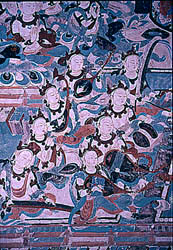
Detail of wall painting from Dunhuang, Mogao Cave 85, showing a group of musicians. Photograph: The Getty Conservation Institute
In August 2000 the Dunhuang Academy will hold an international conference at Mogao to commemorate the centenary of the discovery of the hidden archive in Cave 17. In preparation for the event significant changes are taking place. Landscaping in front of the nine-level pagoda, the centrepiece of the site, and elsewhere has been completed; and the many small-scale commercial activities which had infested the site are now confined to a less intrusive areas. Wang Yuanlu's temple, a few paces from Cave 17, is being reconstructed after having fallen into a state of dereliction.
These changes, much needed, to the presentation and management of the Mogao Grottoes are being undertaken by the Dunhuang Academy under Director Fan Jinshi. They reflect an awareness on the part of the Dunhuang Academy that the World Heritage site of Mogao must adapt and adopt international standards of conservation to meet the growing interest in the site, not least of which is tourism.

The nine-storey pagoda at Dunhuang housing a massive Buddha statue, with landscaping and paving in progress. Photograph: The Getty Conservation Institute
It is no secret that today China bitterly resents the losses from Cave 17 to mainly Western institutions, and to a great degree Chinese scholars have been hampered, and still are, by lack of access to the material. Consequently most research on the documents has been done elsewhere. But, as is widely acknowledged, a consequence of this diaspora has been the rise of a vibrant field of international scholarship resulting in the creation of a separate field of Dunhuang studies. Ironically, research on the documents from Cave 17 seems to have developed to some degree independently from the study of the wall paintings within the cave temples of Mogao, though some recent publications make the synthesis.
A parallel to this situation concerns conservation: little contact has taken place between specialists working to preserve the documents, those dealing with the wall paintings, and others who address the problems of site deterioration. Indeed, at the Silk Road Conference held at Mogao in 1993 only one paper, that by L. E. Fleming, dealt with conservation from Cave 17. This discussed materials and methods used at the British Museum for the conservation of paintings on silk and paper. Insofar as site conservation issues are concerned, the Getty Conservation Institute has for 10 years been working at Mogao in collaboration with the Dunhuang Academy on conservation and researching causes of deterioration and their mitigation.
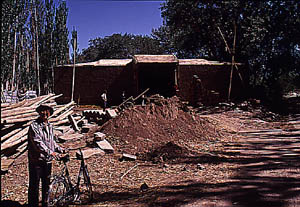
Wang Yuanlu's temple and residence in the process of repair. Cave 17 is just off the left of the picture. Photograph: The Getty Conservation Institute
While it may be argued that there is little reason for art historians and historians of Dunhuang to be concerned with conservation issues whether of the materials removed from the site, or the in situ wall paintings, or indeed of the site itself, it behooves all who have a connection with Mogao to think holistically of the integrity of the site and the wonderful material from it that has sown a discipline whose harvest of scholarship is now being reaped.
As an example of the intersection of scholarship and science one need to look no further than the elegant monograph by Gibbs and Seddon on berberine and huangbo in relation to the Diamond Sutra.[1] Likewise, our own scientific studies with the Dunhuang Academy of the wall paintings at Mogao, currently focused on Cave 85, are examining the binding media, pigments and clay-fibre substrate as a pre-requisite to developing better conservation strategies and techniques. This is in addition to environmental monitoring within the caves, training, documentation and treatment.
One may ask in what ways information from Cave 17 documents might be relevant to site preservation issues. As the Getty Conservation Institute - Dunhuang Academy team grapples with the need to understand causes of deterioration of the wall paintings we ask questions like: what is the history of flooding of the river at the site? Are there records of periods of higher rainfall? The wealth of material from Cave 17 may answer these and other questions. We would like to know.
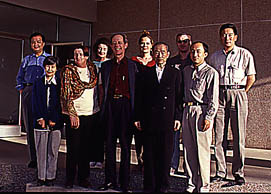
Left:China's Principle staff at Mogao: (l. to r.): Dr. Li Zuixong, Deputy Director, Dunhuang Academy; Fan Jinshi, Director, Dunhuang Academy; Sharon Sullivan, former Executive Director, Australian Heritage Commission; Kirsty Altenberg, Australian Heritage Commission, Neville Agnew, Getty Conservation Institute, Martha Demas, Getty Conservation Institute, Duan Wenjie, Retired Director, Dunhuang Academy; Peter Barker, translator, Wang Xudong, Deputy Director, Conservation Institute, Dunhuang Academy; and Li Shi, Deputy Director, Conservation Institute, Dunhuang Academy. Photograph: The Getty Conservation Institute
The China Projects of the Getty Conservation Institute
The Getty Conservation Institute has been collaborating with the Chinese State Administration for Cultural Heritage (formerly the State Bureau of Cultural Relics) since the beginning of 1989. Under this agreement projects have been concerned, in addition to conservation at Mogao, with the Yungang Grottoes in Shanxi province, and recently, a nation-wide project to develop conservation principles for the heritage sites of China. In the latter project, the State Administration is working with the Getty Conservation Institute and the Australian Heritage Commission to develop policy to guide the practice of heritage conservation and management of sites in China. Economic development in China is leading, in some instances, to inappropriate utilization of heritage resources to generate income and the authorities are anxious to develop a methodology for conservation planning, management and implementation, and to ensure their widespread adoption at this point in time.
The Getty Conservation Institute team recently completed a late spring campaign - from the end of May to mid-June 1999 - at Mogao. There were two objectives in mind: to test and validate the developing policy principles against the reality of conservation and management conditions at Mogao, and to continue work on the wall paintings project at Cave 85, a large Tang dynasty cave. During this campaign, work continued in analysis and study of causes of deterioration of the wall paintings, and documentation of the condition of the paintings was completed. A fruitful exchange of information took place with visiting members of the Tokyo National Research Institute for Cultural Properties, which has also had a long standing presence at Mogao. Additionally, in July two staff members from the Academy, on the joint GCI-Dunhuang Academy team, and one from the State Administration in Beijing will visit the GCI for advanced training in the Institute's laboratories. Next year, further training visits are planned. The project at Mogao is scheduled to be completed at the end of 2002.
[1] Peter J. Gibbs and Kenneth R. Seddon, Berberine and Huangbo: Ancient Colorants and Dyes (The British Library Studies in Conservation Science), The British Library, London 1997, ISBN 0 7123 0649 8.
The Origin of Chess: The Initiative Group Koenigstein

Woodblock print from Sancai Tuhui, a late Ming dynasty encyclopedia by Wang Qi (©The British Library 15024.a.1)
The international Initiative Group Koenigstein (IGK), founded in 1991, is searching for the origin of chess. Was chess created through evolution or revolution? Nowadays there are few chess historians who support the hypothesis that chess was created in a one-person one-moment event. The majority instead assume that chess was developed in an evolutionary process by unifying different games older than chess.
In which location or region, in which melting pot of peoples and cultures, might these game ideas have merged, mingled and been modified? If, contrary to traditional theories, chess did not emerge in India, Persia or China, but if each culture contributed a small part to the whole, we should look for a region where all three cultures existed for chess' origins. One look at an atlas showing the routes of the Silk Road shows clearly that the area around Kashgar (Turkestan) is a prime candidate. All the major routes of the Silk Road met there, including a branch coming from India. (The region around Peshawar might also be a candidate, although it is less centrally located and associated with only the southern route of the Silk Road).
Kashgar was an ideal market place, a cauldron where peoples and cultures met, exchanged ideas, and played games. Even now Kashgar views itself as an agent for both merchandise and ideas. Today it is a Chinese city, but in character it is more like a Persian or Afghan town. Kashgar (in a wider sense, the Silk Road itself) seems to be the ideal location where both of the major chess games may have originated.
Chess is surely more than 1500 years old. IGK wants to expand the search for and research into chess literature and chess artefacts along the Silk Road, including the study of games older than chess. IGK, a unique blend of academics and professionals, can contribute both expertise and experience across a wide range of disciplines.
For a review of some of our work, please visit our web site at: http://www.netcologne.de/~nc-jostenge.
For initial contact please write to:
Mr. Egbert Meissenburg, Elbdeich 164. D 21217 Seevetal, Germany
or e-mail: Mr. Gerhard Josten: gerhardjosten@netcologne.de Gerhard Josten
Stylus-Impressed Writing on the Dunhuang Manuscripts
Yasukazu Yoshizawa and Yoshinori Kobayashi
This article was first prepared for publication on June 15, 1994 and therefore represents the early stage of work in progress. The editor would be glad to receive comments on this work.
Introduction
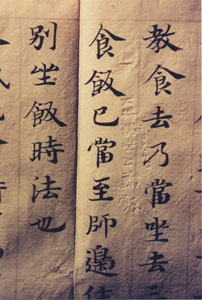
Left:1.Kakuhitsu letters written on a 10th century manuscript in the Ishiyamadera temple. The characters are probably contemporary with the manuscript.
n 1961 one of the authors (Y.K.) discovered impressed characters written on a manuscript using a stylus without ink. By March 1994, impressed characters have been found on over 1,200 manuscripts from all over Japan. This form of writing was commonly used until the end of the 19th century but has since been forgotten. Because the characters are illegible under artificial light, or even in dark natural light, they remained undiscovered for a long time.
Similar impressed writing has since been found in manuscripts outside Japan including, in 1985, on ancient Chinese manuscripts from Beijing, in 1992, on Tibetan Buddhist scriptures and, on a copy of the Persian Qur'an in 1993. Since writing implements used in Japan, such as paper, brush and ink, came from China, the authors hypothesized that this style of writing may also have originated in China.
In 1993 the authors came to the British Library to look at European and Arabic manuscripts, as well as Chinese Dunhuang manuscripts. We discovered impressed writing which, we argue, is related to the Japanese writing.
Kakuhitsu Writing in Japan

Left:2.Wooden stylus,kakuhitsu, found at 'Mitsugi-Hachimangu'.
The stylus used to write impressed characters is called kakuhitsu in Japanese, and examples made of wood, bamboo and ivory have been found at Japanese shrines, temples, palaces and museums. They measure about 24 cm in length and between 0.6-1 cm in diameter. Thin wood fibres were found adhering to some and, on analysis, these were discovered to come from Japanese paper thus proving that the styli were used for writing. Carbon 14 dating is being used to determine their age.

Right:3.Illustration of Hachiman-Daibosatsu-Goengi from Shinto Shrine, 'Mitsugi-Hachimangu', dated 1637. The stylus lines can be seen under the painted lines.
The earliest Japanese manuscript on paper found with this writing is in the Shosoin in Nara and dates from AD 749, but a wooden document from the site of Fujiwarakyo also containing impressed writing dates from the beginning of the eighth century. The latest dated document is found in the Nagaoka family genealogical documents, dating to 1910. This shows that this form of writing was widely used from at least the eighth century to the beginning the twentieth century.
A typical example is shown on the left. Because of the difficulty in seeing these characters, one of the authors (Y.Y.) has invented a 'kakuhitsu scope' which consists of a special lamp, a metallic case, reflectors and filters, and enables the characters to be read and photographed. Most kakuhitsu characters are written in kana giving the Japanese pronunciation and meaning of the classical Chinese, and thus they are very useful for linguistic study of classical Japanese. In this case, the reader used the kakuhitsu notes for private use. In other cases, impressed lines were used for initial drafting of illustrations before the ink and paint was applied.
Stylus impressed writing outside Japan
Stylus impressed marks were discovered over ten years ago on twelfth-century Chinese Buddhist scriptures which had later been brought to Japan. The marks were for punctuation and not written in kanaas aids to the Japanese pronunciation and meaning, suggesting that they were made before the manuscripts were brought to Japan.
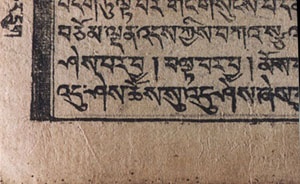
Right:4.Stylus-impressed writing on a Tibetan Buddhist text brought from Darjeeling, India. The writing in the margin is similar to kakuhitsu writing in Japan.
In 1985 the author (Y.K.) discovered similar marks written on Chinese books dating from 1319 and on Han dynasty wooden slips. Further marks were found by Mr Yunoki on fourteen documents from the Ming and Qing periods in Beijing in 1994. All these examples show that impressed writing was also in use in China.
But impressed writing has also been found on manuscripts from further afield, such as Tibetan Buddhist scriptures printed in Bhutan about a century ago and on copies of the Qur'an brought to Japan.
The Dunhuang Manuscripts
In 1993 the authors selected sixteen Dunhuang manuscripts from the Stein collection at the British Library all of which had 'recitation' or 'collated' inscribed at the end of the text. Impressed marks and lines were found on seven manuscripts and faint Chinese characters on one, namely Or.8210/S.5556 (see table 1 below).
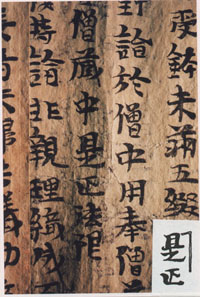
Left:5.Hook-shaped impressed mark on Or.8210/S.797, the oldest, dated Dunhuang manuscript, showing where characters are to be inserted.
In Or.8210/S.797 there is a clear hook-shaped impressed mark adjacent to the character shi (see left) which is an editor's mark, indicating the place where omitted characters are to be added.
In Or.8210/S.5309 there are impressed marks throughout the document and, in some places, the marks have been written over with red ink. It is suggested that the marks were made while students were listening to a lecture about the sutra in question and that afterwards they marked the salient points in red.
In Or.8210/S.5556 (Fig. 6, left) the authors discovered four marks which are probably Chinese characters. For example, fig. 3 shows the impressed character qie next to the ink-written character sha. Tang-dynasty pronunciations of these two characters are thought to be the rhymes ietand atrespectively. We suggest that the character qie was therefore written as a guide to the pronunciation of the character sha.
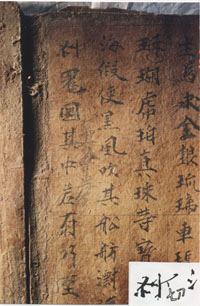
Right:6.Impressed Chinese characterqie on Or.8210/S.5556.
Or.8210/S.5556 (fig. 8, below) also contains the impressed character manplaced next to the ink-written character de.De and the following character, du, have the meaning that manis spiritually awakened in his journey across the sea of human life by following Buddhist teachings. The character manmeans that someone has completed their Buddhist training. The authors therefore suggest that manis meant as a gloss on dedu.
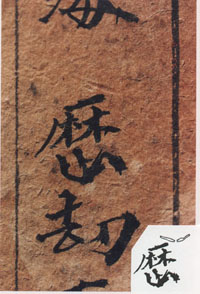
Left:7.Mark like an upside-down French circumflex on Or.8210/S.5556
The manuscripts show several other marks, some of which are also found in red ink and are understood, and others whose meaning or purpose is not yet clear.
Fig. 7 (right) shows a mark like an upside-down French circumflex on the character li.The mark indicates the beginning of a paragraph and is also found written in ink on Or.8210/S.797 (as pointed out by Professor Ishizuka).
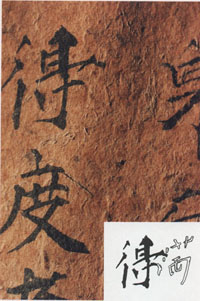
Left:8.Impressed characterman written on Or.8210/S.5556.
Conclusion:
Impressed writing exists in Dunhuang manuscripts from the early 5th to the 10th centuries and, we suggest, was a convenient method for Buddhist students to take notes on their copies of a text during a lecture. Sometimes they wrote over these in ink after the lecture. The further discovery and study of such marks will help us to verify the pronunciation of classical Chinese and the method of Buddhist teaching.
Table 1
Dunhuang Manuscripts Investigated
|
Title of Text 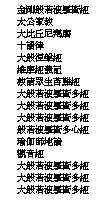 |
BL pressmark Or.8210/S.87 Or.8210/S.479 Or.8210/S.736 Or.8210/S.797 Or.8210/S.2231 Or.8210/S.2231 Or.8210/S.3696 Or.8210/S.3755 Or.8210/S.3841 Or.8210/S.4346 Or.8210/S.4406 Or.8210/S.5309 Or.8210/S.5556 Or.8210/S.6493 Or.8210/S.6592 Or.8210/S.6835 |
Date 700 879 542 406 627 539 n.d. 8th c. n.d. n.d. n.d. 857 (948) n.d. n.d. n.d. |
Impressed Writing? No ? Yes Yes Yes No Yes No No No Yes Yes Yes No No No |
Publications
Old Tibetan Manuscripts from East Turkestan in the Stein Collection of the British Library (3 vols.)
Takeuchi Tsugohito
The Centre for East Asian Cultural Studies for Unesco, The Toyo Bunko & The British Library Board, 1997-.
The plate and syllable index volume are now published and the catalogue volume will be out shortly.
British Library Journal Special East Asian Edition
Vol. 24, No. 1 (Spring 1998)
This issue of the BLJ publishes the photographs of manuscripts Stein found on his Fourth Expedition for the first time. Stein was not allowed to take the manuscripts themselves out of China and the whereabouts of the originals is not known. These photographs are therefore the only record of the documents. In his article, Wang Jiqing from Lanzhou University introduces these manuscripts. The journal also carries relevant articles by Professor Rong Xinjiang, Peking University ('The Historical Importance of the Chinese Fragments from Dunhuang in the British Library'), and by Dr Susan Whitfield, IDP ('Under the Censor's Eye: Printed Almanacs and Censorship in Ninth-century China').
Religions of the Silk Road: Overland Trade and Cultural Exchange From Antiquity to the Fifteenth Century
Richard C. Foltz
New York: St. Martins Press, 1999.
USD24.95 cb 208 pp., ill., maps. ISBN 0-312-21408-1.
This book explores the relationship between mercantile and missionary activity along the trans-Asian trade routes in pre-modern times, focusing on the transmission of religious ideas from West to East. The role of Sogdians and other Iranian-speaking peoples in facilitating cultural exchange is emphasized. The Silk Road is shown to have been more than simply a conduit along which goods and ideas moved from one place to another. As the histories of Buddhism, Manichaeism, Nestorian Christianity and Islam attest, travel along the Silk Road was a transformative rite of passage.
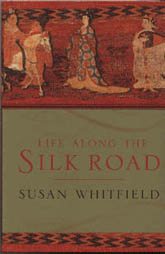
Life Along the Silk Road
Susan Whitfield
London: John Murray, GBP19.99 hb
University of California Press, USD24.95 cb
288 pp., 16 pp. colour & b&w ill., line ill., map, ISBN0-7195-5757-7
In the first millennium AD, merchants, missionaries, monks, mendicants and military men lived and travelled on the vast network of Central Asian tracks that became known as the Silk Road. The route passed through many countries and numerous settlements, from the splendid city of Samarkand to tiny desert hamlets. This book recounts the lives of some of these people and the towns in which they lived between the eighth and tenth centuries: Kumtugh, a Uighur nomad from the Dzungarian basin accompanying a herd of steppe ponies for sale to the Chinese emperor; Widow Ah-long, wife of a wealthy landowner accustomed to dispensing largesse to the Buddhist church yet reduced to near poverty after her husband's death and forced to resort to law to survive; the Chinese princess sent as part of a diplomatic deal to marry a Turkic kaghan; a Tibetan soldier; a Sogdian merchant; and many more.
Conservation and Science
IDP Workshop
A very successful workshop was held on Friday 9 July at the British Library to review the scientific work being done on Dunhuang manuscripts and its application to the issue of distinguishing between genuine and forged manuscripts. Summaries of the papers presented are given below.
Comparison on Paper Fibre Identification on the Sven Hedin and Stein Collections
Anna-Grethe Rischel, The National Museum of Denmark
A full version of Ms Rischel's work will be published in the forthcoming volume on forgeries and so is not reproduced here.
Beyond the Pale: Methods of Detecting Paper Bleaching
Sandy Ryan, The British Library
Sandy Ryan's work over the past few years has been to review the development of chemical bleaching, from its origins in the textile industry to its use in paper conservation. She analysed papers bleached by sodium hydrochlorite, potassium permanganate and oxalic acid using scanning electron microscopy (SEM), Fourier transform infrared (FTIR), electron paramagnetic resonance (EPR) and near infrared (to generate data for multivariate analysis), to see if the treatments could be determined. FTIR was not effective. SEM shows the effect of some treatment, but cannot be used qualitatively to differentiate between treatments. EPR, at this stage, detected free radicals of organic origin and was able to identify all instances of potassium permanganate bleaching by the signal generated by the Mn(II) centre. The multivariate analysis was able to determine which samples had been bleached with permanganate and with oxalic acid.
Analysis of Dunhuang Manuscripts by Raman microscopy
Lucia Borgio, University College,London
Raman microscopy is now considered to be the best single technique for the analysis of materials used on works of art, especially pigments. It is non destructive and it can be applied in situ,therefore avoiding any sampling and consequently any damage to the object under examination.It is very reliable, sensitive and specific, providing the exact identity of the pigment analysed (any molecule is characterised by a Raman fingerprint); Moreover, the spatial resolution achieved can be as high as 1 mm, an important detail when the components of a complex pigment mixture are to be identified.The Raman microscopic analysis and identification of pigments on works of art is desirable for the following purposes: it can provide information useful for conservation, consolidation and restoration purposes; it is a valuable aid in the dating and authentication of any artefacts; it can effectively support historical studies. A few manuscripts from the Stein collection at the British Library have been analysed in order to identify their pigments and inks. The following pigments have been detected: vermilion, red lead, orpiment, haematite and carbon. All these pigments are available in nature, and therefore their presence is in perfect agreement with the dates provided by the British Library. On the other hand, no modern synthetic pigments which could have been present on a 20th century modern forgery have been detected.
Chemical Analysis of Dyes on a Selection of Dunhuang Manuscripts
John Fields, The Queen's University of Belfast
A novel liquid secondary ion mass spectrometric (L-SIMS) technique, devised at the Queen's University of Belfast, has allowed the in situidentification of the components of the yellow dye huangbo on ancient paper samples contemporary with the Dunhuang Diamond Sutra. This non-destructive technique then allows the samples to be further analysed by Subtracted Shifted Raman Spectroscopy (SSRS) and IR Microscopy, which are also non-destructive and in situ techniques. Finally, a high performance liquid chromatographic technique, which detects the presence of berberine, palmatine and jatrorrhizine and confirms their presence by UV/vis spectroscopy, has been used. However, the HPLC method for the detection of huangbo is a destructive technique as it involves the extraction of the dye from the paper sample, and must only be used when all other examination has been completed. It is difficult to draw any firm conclusions about the value of dye analysis on establishing whether a particular manuscript is genuine or fake without also considering the studies on calligraphy, paper structure and content. However, the methodology looks very promising, and further investigations to calibrate the techniques against both authentic and 'authentic' fakes are continuing.
Investigation of Scientific Dating of Stein Items in the British Museum Collection
Anne Farrer The British Museum has recently been investigating the scientific dating of objects. Results will be carried in a future issue of IDP News.
Computer Identification of Fragments of Buddhist Texts
Professor Lewis Lancaster,University of California at Berkeley
80,000 woodblocks of the Korean canon carved in the 13th century still exist in Korea at the Haein-sa Temple and, over the past decade, a full-text digitial version of the Buddhist canon has been compiled using these woodblocks. Their importance cannot be underestimated. As Professor Lancaster explained, the CD containing the full text can be used to check for authenticity of the manuscripts because the woodblocks use old forms of characters contemporary with the Dunhuang manuscripts but unknown to many modern forgers. Another use of the CD is in identifying small fragments of text. Using a freely available search programme, Professor Lancaster demonstrated how the Tripitaka can be searched for a string of characters in a matter of minutes. In his three weeks at the library he was able to identify about 85% of the fragments he examined using this method. In the other cases, too many hits were found, but a more sophisticated search engine would allow for searching using non-contiguous characters and defining the proximity, thus reducing the number of hits. This tool will allow for much quicker cataloguing of fragments, and Professor Lancaster also demonstrated a virtual library system, whereby the fragments are 'filed' in the appropriate virtual texts, making retrieval both intuitive and fast.
Other News
Congratulations to John Fields who has been appointed as Conservation Scientist in the Conservation Research Group at the British Museum. He will take up his post after his doctoral viva voce later this summer and we wish him every luck, both in the viva and in his new job.
The volume of papers from the forgeries conference will be published later this year and full details will be given in the next issue of IDP News.
Conferences
LANGUAGE AND CULTURE MAINTENANCE IN THE ALTAIC WORLD
Permanent International Altaistic Conference (PIAC)
42nd Meeting
22-27 August 1999
Prague,Czech Republic
For details contact:
Secretary General, PIAC
Goodbody Hall
Indiana University
Bloomington
Indiana 47405, USA
Fax: +1 812 855 7500
Email: sinord@indiana.edu
THE INTERNATIONAL ASSOCIATION OF BUDDHIST STUDIES (IABS)
XIIth Conference
23-28 August, 1999
Lausanne, Switzerland
For details contact:
XIIth IABS Conference
Dept. of Oriental Languages and Cultures
University of Lausanne
B.F.S.H. 2
CH-1015 LAUSANNE
Switzerland
Fax: +41 21 692 3045
Email: iabs99@orient.unil.ch
WWW: http://www.unil.ch/orient
THE SECOND ANNUAL AVESTA CONFERENCE
Zoroastrian Association of Alberta
24-26 September, 1999
Calgary, Alberta, Canada
For details contact:
Zoroastrian Education and Research Society
253 S. 4th Street,
Womelsdorf, PA 19567, USA
Email: Pichaporia@aol.com or Fmehta@rng.com
FOURTH ANNUAL WORKSHOP ON CENTRAL ASIAN STUDIES
21-24 October, 1999
University of Wisonsin, Madison, USA
The goal of this workshop is to discuss how to research, teach and co-ordinate efforts in the Central Asian field.
For details contact:
Center for Russia, East Europe and Central Asia
University of Wisconsin-Madison
210 Ingrham Hall
1155 Observatory Drive
Madison WI 53706-1397 USA
Fax: +1 608 265 3062
Email: creeca@macc.wisc.edu
WWW: http://polyglot.lss.wisc.edu/creeca/
DUNHUANG 2000
The International Academic Conference on the Centenary of the
Discovery of the Dunhuang Manuscript Cave (No. 17)
21-25 June, 2000
Capital Normal University, Beijing, China
For details contact:
Hao Chunwen
Dept. of History
Capital Normal University
BEIJING 100089
The People's Republic of China
Tel: +86 10 6890 3561
Fax: +86 10 6890 2315
Email: Haochunwen@ihw.com.cn
OR Haocw@mailhost.cnu.edu.cn
DUNHUANG 2000
INTERNATIONAL CONFERENCE ON DUNHUANG STUDIES
August, 2000
Dunhuang, China
The conference is scheduled to last six days, the first four days for papers and discussion and the last two days to include visits to the Mogao caves, Yulin caves, West Qianfodong, Yumen Pass and the Han dynasty Great Wall. Spaces are limited to 170 delegates. Participants will be expected to pay a registration fee (which includes local travel for the cave visits), travel to and from Dunhuang, accommodation and other expenses. Further details will be sent with the second announcement in August.
For details contact:
Mr Zhang Xiantang
Assistant Secretary General
Commission of Academic Research
Dunhuang Research Academy
Mogaoku, DUNHUANG 736200
The People's Republic of China
Tel: +86 937 886 9027
Fax: +86 937 886 9028
Email: dhbhlz@public.lz.gs.cn
36th ICANAS
27 August - 1 September, 2000
Montreal
From Dunhuang to Kucha, from the Han to the Northern Song
Dunhuang and Turfan Symposium of the International Dunhuang Project and the Groupe de recherche sur Dunhuang, Instituts d'Extreme-Orient
In continuation of the last Dunhuang - Turfan Symposium, held with great success as part of the 35th ICANAS in Budapest 1997, we would like to invite you to take an active part in the next symposium to be held in Montreal 2000.
Existing panels include:
Cross-cultures 1: Monks and Merchants
Cross-cultures 2: Property and Techniques
Dunhuang Calendars
A Comparitive Evaluation of the Qin-Han and Dunhuang Manuscripts on the Mantic Arts
Text and Image at Dunhuang and Turfan
Buddhist Apocrypha
Digital Reconstruction and Computers in Art History
Daoist Texts
Turfan Manuscripts
Problems of Restoration and Conservation
Please send your paper or panel proposals to any of the organisers as soon as possible. The symposium is part of the 36th ICANAS and participants will be expected to register for this and will receive all general details from the ICANAS organising committee.
(WWW: http://www.bcoc.umontreal.ca
Email:congres@bcoc.umontreal.ca)
A second circular and further details will be sent after the preliminary programme of the symposium has been fixed.
Organisers of the Special Symposium:
Professor Jean-Pierre Drege
Unite mixte de recherche Civilisation chinoise
Groupe de recherche sur Dunhuang
Instituts d'Extreme-Orient
52, rue du Cardinal Lemoine
75116 Paris
Fax: +33 1 44271854
Email: jpdrege@ext.jussieur.fr
Dr Simone-Christiane Raschmann
Katalogisierung der Orientalischen
Handschriften in Deutschland Arbeitsstelle Berlin II: Turfanforschung
Unter den Linden 8, D-10109
BERLIN, Germany.
Fax: +49-30-20370 467
Email: raschmann@bbaw.de
Dr Susan Whitfield
The International Dunhuang Project,
The British Library
96 Euston Road
LONDON NW1 2DB, UK.
Fax: +44 171 412 7858/7641
Email: susan.whitfield.@bl.uk
Project News
Study Tour
A study tour to Dunhuang and other Silk Road sites was organised for patrons and friends of IDP in May 99 led by Colin Chinnery and Susan Whitfield. The group went overland by train and minibus from Xian to Kashgar, visiting Buddhist caves and other ancient sites at Maijishan, Dunhuang, Turfan and Kucha. Susan Whitfield and Colin Chinnery's participation was made possible through the Sino-British Fellowship Trust.
Colin Chinnery and Susan Whitfield held very useful talks with The National Library of China during their May visit to Beijing about possible future collaboration. In Dunhuang, they attended two meetings chaired by Professor Fan Jinshi, Director of the Dunhuang Academy, to discuss the Dunhuang 2000 events. Professor Fan and her colleagues were most generous with hospitality during the IDP group's stay in Dunhuang and we would like to thank them for their help. We hope that IDP and the Dunhuang Academy can carry forward their discussions and cooperation. IDP has invited Professor Fan and Professor Shi Pingting to visit the British Library in autumn 1999 to see the Stein collections and the photographs, and to continue the discussions.
Workshop
An IDP workshop on techniques to identify forgeries was held on Friday 9th July at the British Library. See above for a full report.
People
Sam van Schaik started work on the Project on 28 June 1999. Mr van Schaik will be working on the scanning and preliminary cataloguing of the Tibetan woodslips from Stein's second and third expeditions, in conjunction with Professor Tsugohito Takeuchi who will be preparing a full catalogue on the database. This work is made possible through a generous grant from the UK Heritage Lottery Fund. Professor Takeuchi spent a week in London from 3rd July at the invitation of IDP to discuss the cataloguing work with Mr van Schaik.
We must also thank Thomas Schmieder-Jappe from Staatsbibliothek, Berlin, who spent three weeks at the British Library in the spring, and two volunteers, Bettina Lloyd and Nicole Willock. Their help on the project in 1999 has been enormously appreciated.
Dr Kesina Kepping from the Institute of Oriental Studies, Russian Academy of Sciences, St. Petersburg Branch, spent one week in London in June at the invitation of IDP to discuss the cataloguing of the Tangut fragments. The fragments are now being scanned and preliminary details entered on to the database. Dr Kepping will provide full catalogue entries over the next two years. Dr Kepping's work will be funded by a generous grant from the UK Heritage Lottery Fund.
Professor Lewis Lancaster from the University of California at Berkeley spent three weeks at the British Library in June/July to work on Stein Buddhist fragments. He was testing the use of the full text Korean Tripitaka on CD for identifying from the few characters found on many of the fragments. The system proved extremely successful with Professor Lancaster being able to identify over 85% of the fragments he examined. In most of the other cases, the characters on the fragment were too common to isolate a single text: too many hits were found. During his stay, Professor Lancaster gave a very well-received lecture on the Electronic Cultural Atlas Initiative (ECAI) and presented the text identification system to the IDP Workshop (see above).
Professor Oktor Skjaervo spent four weeks at the British Library in June finalising his work on the catalogue of Stein Khotanese texts. His catalogue will be published by the British Library and full details will be given in IDP News.
Sponsor a Sutra
Thank you to all of those who have sponsored a sutra, thus enabling our work of digitisation to proceeed apace. I will soon be adding a list of sponsors to the web site. There are still many thousands of manuscripts left to digitise so if you would like further details of this scheme please contact IDP or look at the Sponsor a Sutra page.
Web Site
The IDP Interactive Web Database is currently being upgraded to enable more convenient and easier searches and to give accessibility to more information. The upgrade is scheduled for the autumn.
